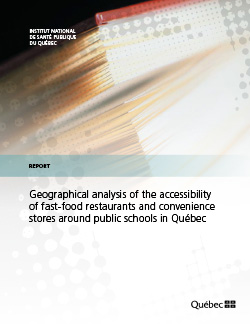Geographical analysis of the accessibility of fast-food restaurants and convenience stores around public schools in Québec
In Québec, nearly one in five children suffers from excess weight and the situation has greatly deteriorated over the past 25 years. This situation results from a large number of individual and environmental factors, including the food environment around schools. In the United States, a number of studies have documented the substantial presence of fast-food restaurants and convenience stores around schools. These types of food outlets are also more numerous around schools in disadvantaged neighbourhoods. In Québec, aside from the island of Montréal, not much is known about the food landscape around educational institutions or around schools in rural areas.
Method
Ten- and fifteen-minute walking zones were defined around public schools in Québec (n = 2302). Fast-food restaurants (n = 1787) and convenience stores (n = 3446) included in these zones were selected using a business directory and names of business. Logistic regression analyses were conducted using dichotomous variables (presence or absence of fast-food restaurants and convenience stores). Analyses were carried out for zones that are within 10- and 15-minute walks around schools. Different models were developed for schools located in rural settings and those in urban areas. Regression models also include variables that characterize the schools (education cycles and level of deprivation).
Results
Results show that within a 15-minute walk of public schools in Québec, there is a least one fast-food restaurant and one convenience store, or 37% and 62% respectively. These figures do not change significantly for most health regions in Québec. In urban settings, such as Montréal and Laval regions, there are more schools with food outlets nearby. High schools (rural and urban) are more likely to have at least one fast-food restaurant within a 10-minute walking distance. Schools located in urban settings where the level of deprivation is high are significantly more likely to have a fast-food restaurant nearby; this relationship is not significant for convenience stores. However, the probability that a convenience store is located within a 15-minute walking zone from a school is significantly greater for high schools in rural areas.
Conclusions
The close proximity of fast food restaurants and, more specifically, convenience stores around schools could counter the provincial government's efforts regarding the implementation of a healthy food policy in these schools. Further analyses of the proportion of students using these businesses, however, should be performed to better estimate their impact on the eating habits of young people.


